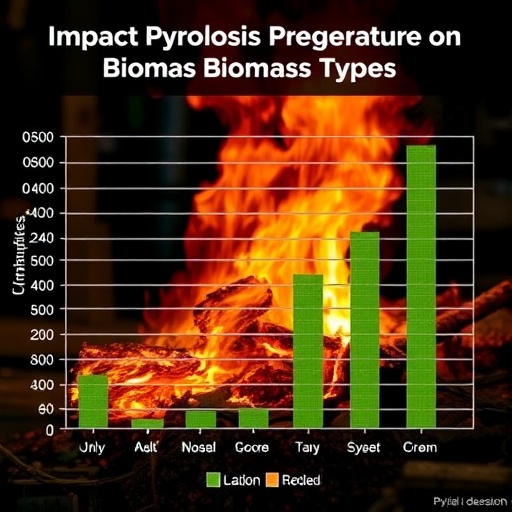The field of biomass conversion has garnered significant attention in recent years, notably for its potential to contribute to sustainable energy solutions and mitigate climate change. In a groundbreaking study titled “The Critical Role of Pyrolysis Temperature: A Comparative Study of Corn Stover, Rice Straw, Rice Husk, and Sawdust,” researchers Zhou, Xu, and Huang delve into the intricacies of pyrolysis—a thermochemical process that transforms organic material into biochar, bio-oil, and syngas under anaerobic conditions. Their work highlights the critical influence of pyrolysis temperature on the yield and quality of the end products derived from various biomass sources, each of which presents its own unique set of characteristics and challenges.
Pyrolysis temperature is a pivotal variable that dictates the efficiency of biomass conversion. The researchers meticulously designed their experiments to compare the effects of varying temperatures on the four different types of biomass: corn stover, rice straw, rice husk, and sawdust. Each feedstock has a distinct composition, which means that pyrolysis outcomes can greatly differ based not only on the material itself but also on the temperature at which the pyrolysis occurs. Temperature inversely affects the production of biochar, while a higher temperature is generally associated with increased yields of bio-oil and syngas, underscoring the complexity of optimizing pyrolysis conditions for diverse biomass feedstocks.
The initial findings of the investigation reveal that corn stover, when subjected to high pyrolysis temperatures, showcases an impressive output of bio-oil, making it a frontrunner among the tested biomass types. This is particularly noteworthy given corn stover’s widespread availability as an agricultural residue, which, if utilized effectively, could help reduce reliance on fossil fuels and enhance energy security. Additionally, the study articulates how these findings could frame future policies aimed at promoting biomass-derived energy sources, casting a spotlight on the role of agricultural waste management in sustainable energy practices.
Rice straw showed a different profile under pyrolysis, as its higher silica content significantly impacted the biochar’s properties. While lower temperatures produced a more porous biochar, conducive to agricultural applications, elevated temperatures yielded biochar with enhanced structural integrity, which could be an advantage for carbon sequestration initiatives. This duality in outcomes suggests that harnessing rice straw effectively requires careful manipulation of pyrolysis conditions to match end-use applications—whether for soil amendment or carbon storage.
Rice husk, often dismissed as agricultural waste, emerged as a formidable feedstock in this study due to its high lignin content. The optimal pyrolysis temperature not only enhanced the quality of the biochar derived from rice husk but also increased the production of syngas, a clean energy vector with considerable potential for power generation. The findings advocate for the diversification of energy feedstocks beyond conventional materials, demonstrating the potential of underutilized agricultural residues in contributing to a circular economy.
Sawdust, commonly regarded as a low-value byproduct of the timber industry, exhibited remarkable syngas yields when subjected to high-temperature pyrolysis. The researchers’ data indicate that with the rising global demand for renewable energy, leveraging sawdust could transform a waste issue into an energy solution. Additionally, the synergy between sawdust-derived biochar applications in soil enhancement and its utilization in wastewater treatment illustrates the multifunctional potential of this biomass source.
Throughout their research, Zhou and colleagues emphasize the necessity of refining pyrolysis technologies to improve overall efficiency and product quality. They advocate for continuous progress in reactor designs that can dynamically adjust temperatures and residence times, thereby offering tailored pyrolysis solutions that meet specific feedstock requirements. Innovation in this space could pave the way for decentralized bioenergy systems that empower local economies and reduce transportation emissions by converting biomass into valuable energy forms on-site.
Moreover, the implications of the study stretch beyond technical enhancements; they touch on socio-economic considerations. With rising global populations and increasing agricultural production, the careful management of biomass resources presents both a challenge and an opportunity for food and energy security. The researchers urge stakeholders—from farmers to policymakers—to recognize the potential that various biomass sources hold not only in energy generation but also in improving soil health and sequestering carbon.
The examination of pyrolysis temperature’s impact on these selected biomass types also aligns with the broader goals of sustainable development and waste reduction. By efficiently converting agricultural residues into valuable energy and materials, meaningful strides can be made towards achieving climate resilience. This research could serve as a paradigm shift towards integrating biomass energy systems into existing agricultural practices, enhancing soil carbon stocks while generating renewable energy.
In conclusion, the study by Zhou, Xu, and Huang propels the conversation around biomass pyrolysis into new realms of understanding. It meticulously catalogs the variable effects of pyrolysis temperature on different feedstocks, compelling the scientific community to consider bespoke strategies tailored to the peculiarities of each biomass. As we navigate the complexities of climate change and energy transitions, these insights will be critical for developing integrated solutions that harness the full potential of biomass—ultimately contributing to a more sustainable and circular economy for future generations.
Subject of Research: Biomass Conversion through Pyrolysis
Article Title: The Critical Role of Pyrolysis Temperature: A Comparative Study of Corn Stover, Rice Straw, Rice Husk, and Sawdust
Article References: Zhou, H., Xu, Z., Huang, Y. et al. The Critical Role of Pyrolysis Temperature: A Comparative Study of Corn Stover, Rice Straw, Rice Husk, and Sawdust. Waste Biomass Valor (2025). https://doi.org/10.1007/s12649-025-03334-9
Image Credits: AI Generated
DOI:
Keywords: Pyrolysis, Biomass Conversion, Renewable Energy, Biochar, Climate Change, Agricultural Residues
Tags: biochar production from biomassbiomass conversion processesbiomass feedstock characteristicscomparative study of biomass typescorn stover pyrolysis resultsimpacts of temperature on bio-oil yieldpyrolysis temperature effectsrice husk pyrolysis outcomesrice straw energy potentialsawdust thermochemical conversionsustainable energy from biomassthermochemical processes for renewable energy





